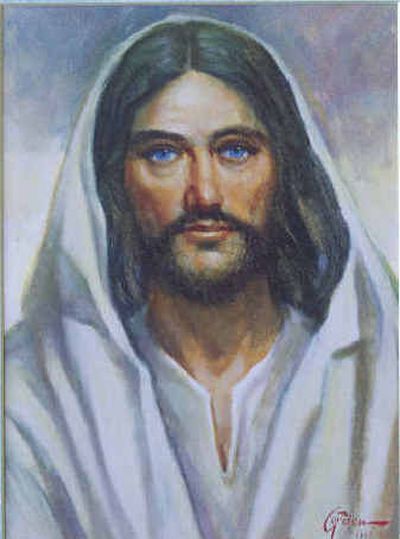Image of Jesus

IRONDEQUOIT, N.Y. — For 60 years, Stanley Gordon has painted life-size portraits of “great achievers” who caught his eye but never came to his studio: John F. Kennedy, Mother Teresa, Arnold Palmer, Pope John Paul II, Sophia Loren.
His most talked-about subject — one he’s struggled to capture on canvas since being awe-struck at age 8 by an ancient scene hanging over his grandmother’s fireplace — has the rugged features of a desert wanderer, the powerful gaze of a revolutionary prophet.
It’s Jesus Christ — or, more accurately, how Gordon imagines the son of God might have looked when he walked the Earth.
The 1997 work has become one of the most widely reproduced images of its kind in decades: 280,000 copies, at last count.
“I don’t believe in religion at all. It’s all man-made, all hype. I stopped a long time ago going to church,” grumbles the 84-year-old Gordon, sitting in a house festooned with hundreds of portraits, drawers filled of sketches and perhaps a million photographs.
“But I’m impressed with Christ, and I have great respect for people with faith. They buy it, they live with it, and they love it. I had no idea it was going to become this big.”
Gordon honed his craft during World War II with speedy charcoal sketches of soldiers lying wounded in U.S. hospitals or cloistered in weather stations and military posts in Iceland, Greenland and Baffin Island.
One day in 1948, his mother mentioned her intention to buy a picture of Jesus at a religious store.
“I said, ‘Wait a minute!’ ” Gordon recalls.
The down-to-earth figure he created — with backlighting instead of a halo, and looking directly at the viewer instead of “off to the side or into the distance or up at heaven” — thrilled his mother so much, his new wife soon demanded one of her own. Over the years, he painted a dozen more.
It was the 15th of his 16 portraits of Jesus that drew worldwide attention.
Dan Morgan, a resort developer and longtime friend, bought it from Gordon and got it displayed on the QVC shopping channel in 2000. All 2,000 of the 16- by 20-inch color prints sold out in five minutes at $49.99 a pop.
Sustained by rekindled interest in all things spiritual since the Sept. 11, 2001, terror attacks, Morgan is still selling thousands of prints a month through QVC, Avon, infomercials and the Internet ( www.faceofjesus.com).
Gordon isn’t getting rich off the deal, estimating he’s earned less than $20,000 in royalties. But he insists, “I don’t care. Dan created this into the greatest portrait of Jesus in the world.”
Morgan declined to discuss financial specifics, saying only that “it’s a ministry to me.”
As a child, he said, “there were portraits of Jesus in every home you walked into just about, then for some reason they disappeared. I never dreamt I could make this much of a difference.”
Morgan imprinted the image on a half-million posters for World Youth Day in 2002 and on another half-million laminated cards delivered to chaplains overseas. Now he’s “taking it up a notch” by creating sophisticated “canvas transfers.”
Scholars say the most widely distributed image of Jesus was Warner Sallman’s 1940 “Head of Christ.” Reproduced about 500 million times, it hung in churches and homes across the United States from the 1940s to the 1970s, when it fell out of favor.
That picture presented a white Christ with fair skin, blue eyes, brown beard, shoulder-length hair and a bright halo behind his head.
Gordon thinks such “three-quarter-profile” portraits are charming but uncommunicative.
“There’s no vibration,” he said.
Captivated as a child by his Uncle Joe’s reproduction of a 17th-century Rubens masterpiece of Christ being removed from the Cross, Gordon stuck to a postwar trend of removing Jesus from a biblical scene and giving him a human as opposed to a divine feel.
His vision mixes traditional and unfamiliar elements: clipped brown hair, a medium-length beard, a slightly olive complexion and unusually striking blue eyes. Brown eyes wouldn’t allow for as much expressiveness, he said.
“It has gentleness, it has passion, and it has that steely eyed look like he’s saying, ‘I’m here to lead the world to the righteous way of living,’ ” Gordon said. “People seem to connect with it. There’s the feeling he’s pulling you toward him, combining your mind and his mind.”
Stephen Prothero, a Boston University religion professor who wrote “American Jesus: How the Son of God Became a National Icon” (Farrar Straus & Giroux, 2003), said the image is sterner, more masculine and world-weary than classic ones, though he finds the eyes “very strange” in a “fairly Semitic-looking” face.
“He does look serious, which I think is appropriate for the times,” Prothero said. “He does not look sweet and friendly. This is a guy who’d enlist in a battle with you.”